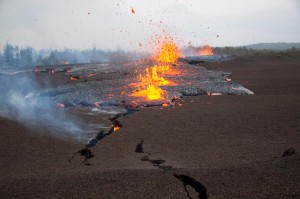Overlook Crater Anniversary Approaching
Wednesday will mark the sixth anniversary of a major change in the ongoing eruption of Kilauea.
Since its beginning on Jan. 3, 1983, the volcano’s eruption had focused on Kilauea’s east rift zone. Major lava flows were generated at the low shield formation of Kupaianaha, and at and around the Pu`u `O`o cone, where it continues to erupt today.
But on March 19, 2008, a crater more than 100 feet wide opened along the wall of Halema`uma`u Crater at Kilauea’s summit.
The event followed several months of increasing seismic activity and gas emissions in the summit area.
Scientists at the nearby Hawaiian Volcano Observatory dubbed the new pit the “Overlook” crater, for its location directly below the closed visitor overlook.
Over the next two years, collapsing of the overhanging crater walls caused Overlook to grow, HVO scientists noted in their latest installment of the weekly Volcano Watch column.
Although lava was present in the crater, at a depth of more than 600 feet it was difficult to see.
Meanwhile, several small explosions threw rocks and fresh lava spatter around Halema`uma`u’s rim.
In February 2010, the lava lake slowly began to rise.
It disappeared only once, in March 2011 during the 4½-day Kamoamoa fissure eruption between Pu`u `O`o and Napau Crater, where activity has also occurred over the past 31 years.
An abundance of gas bubbles has given the lava in Overlook a very low density, close to that of water, HVO scientists said.
The lava level also moves in tandem with the pressure of the summit’s magma chamber, making Overlook act like a liquid pressure gauge.
Recently, the lake has moved to within 100 to 200 feet of Halema`uma`u’s floor, and it frequently throws spatter 65 feet into the air at its southeast side.
It has also grown quite large.
Geologists say it currently measures about 660 feet long and 525 feet wide, making it one of the largest lava lakes on Earth.
And there is no indication that Overlook will disappear anytime soon.
Halema`uma`u previously had lava-lake activity for more than a century, from at least 1823 to 1924.
“Now entering its seventh year, the current eruption may turn out to be a repeat performance of Halema`uma`u’s sustained lava lake,” HVO said.
The new activity has had its downside.
Although the new phase of the eruption has boosted tourism by enhancing viewing opportunities, especially compared with the activity at the remote east rift, it has had negative effects for those living and farming downwind in Ka`u.
The elevated gas emissions or vog are an irritant to those with respiratory problems. They are also acidic, causing burning of cultivated plants and increased corrosion of metal fencing crucial to farming and wildlife conservation efforts.









